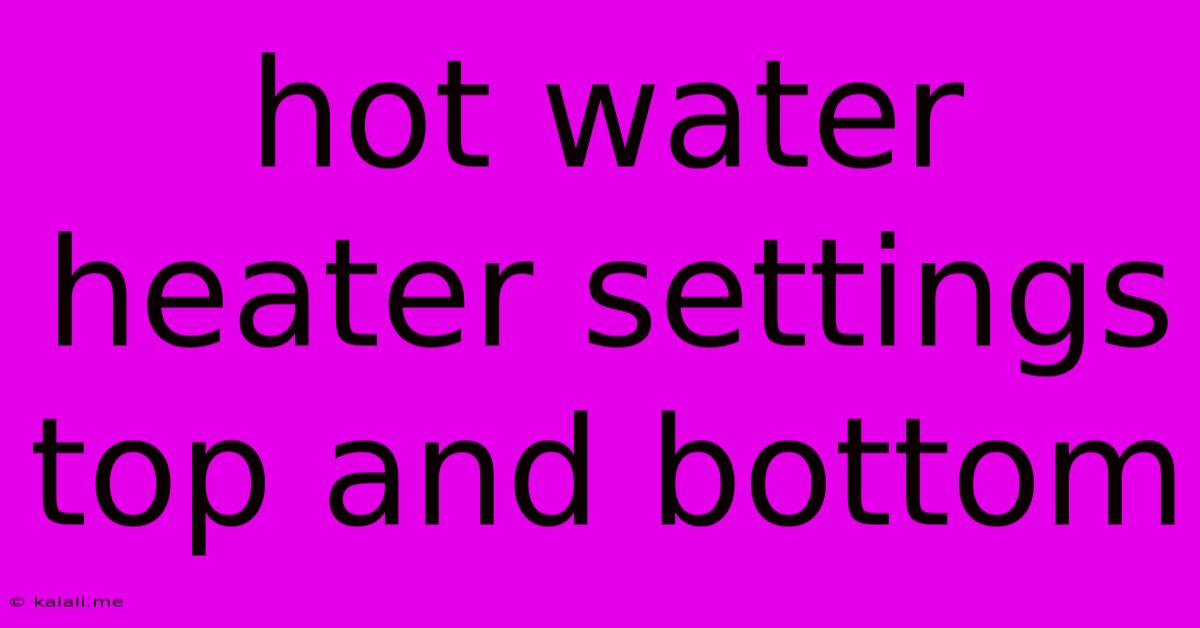Hot Water Heater Settings Top And Bottom
Kalali
May 25, 2025 · 3 min read

Table of Contents
Decoding Your Hot Water Heater Settings: Top vs. Bottom
Are you mystified by the temperature settings on your hot water heater? Many homeowners don't realize their water heater likely has two temperature settings: one for the top element and one for the bottom. Understanding these settings can lead to significant energy savings, improved water safety, and a more efficient system. This guide will break down the intricacies of top and bottom hot water heater settings, helping you optimize your water heating system for maximum performance.
What are the top and bottom elements in a hot water heater? Most tank-style electric water heaters use two heating elements: one positioned near the bottom of the tank, and the other near the top. These elements work in tandem to heat the water, with the bottom element primarily responsible for initial heating and the top element maintaining the temperature. Gas water heaters typically only have one burner located at the bottom.
Understanding the Temperature Settings: While gas water heaters have a single temperature dial, electric models often have separate temperature controls for each element. These settings are usually expressed in degrees Fahrenheit (°F). The exact location and labeling of these settings can vary depending on the manufacturer and model of your water heater.
Optimizing Your Hot Water Heater Settings:
The ideal temperature setting for your hot water heater is a balance between safety and energy efficiency.
-
Safety First: The generally recommended temperature setting for hot water heaters is between 120°F (49°C) and 125°F (52°C). This temperature is hot enough for most household needs, while minimizing the risk of scalding, particularly for children and the elderly. Setting it too high increases the risk of burns and also wastes energy.
-
Energy Efficiency: Setting your water heater too high significantly increases energy consumption. The hotter the water, the more energy it takes to maintain that temperature. By lowering the temperature to the recommended range, you can reduce your energy bills considerably without compromising comfort.
-
Top Element Considerations (Electric Water Heaters Only): In electric water heaters, the top element often kicks in only when the water temperature drops below a certain threshold. While you can adjust the setting on some models, it's usually best left at the manufacturer's default or slightly lower than the bottom element. This ensures consistent temperature throughout the tank and prevents unnecessary energy usage.
-
Bottom Element Considerations (Electric and Gas Water Heaters): The bottom element (or burner, in gas water heaters) is the primary heating source. This element does the bulk of the work in raising the water temperature to the desired setting. You should primarily focus on adjusting this element's temperature to achieve optimal settings.
-
Regular Maintenance: Beyond adjusting settings, remember regular maintenance is crucial. This includes flushing the tank to remove sediment buildup which can reduce efficiency and potentially damage the heating elements. Check your anode rod periodically as well, which helps prevent corrosion.
Troubleshooting Common Issues:
-
Lukewarm Water: If your water isn't getting hot enough, first check the temperature settings. Ensure both the top and bottom elements (if applicable) are set correctly. A clogged sediment build-up might also be the culprit.
-
Water Too Hot: If your water is excessively hot, lower the temperature settings, especially the bottom element setting. Remember that the top element will only turn on if the water temperature significantly drops.
-
Inconsistent Water Temperature: Inconsistent water temperature could indicate problems with the heating elements themselves or a faulty thermostat. Consider contacting a professional plumber or water heater technician.
By understanding the nuances of your hot water heater settings and implementing the tips in this guide, you can achieve optimal water temperature, improve energy efficiency, and enhance overall household safety. Remember, safety should always be your top priority. If you're unsure about any aspect of your hot water heater maintenance or settings, consult a qualified professional.
Latest Posts
Latest Posts
-
How To Spell On In Spanish
May 25, 2025
-
How To Remove A Screw With A Broken Head
May 25, 2025
-
How To Wash Rust Stains From Clothes
May 25, 2025
-
We Have Taken A Very Strong Exception
May 25, 2025
-
Can I Pack A Razor In My Carry On
May 25, 2025
Related Post
Thank you for visiting our website which covers about Hot Water Heater Settings Top And Bottom . We hope the information provided has been useful to you. Feel free to contact us if you have any questions or need further assistance. See you next time and don't miss to bookmark.